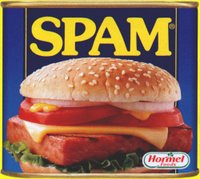Spam Wars
 Back in April, I got an email from Cox Communications, my ISP, touting all the fancy new "features" they had installed on their email service. It included this at-first-glance seemingly innocuous passage:
Back in April, I got an email from Cox Communications, my ISP, touting all the fancy new "features" they had installed on their email service. It included this at-first-glance seemingly innocuous passage:
Control over Spam: In addition to blocking millions of unwanted emails from reaching our customers, Cox heard your requests and now offers the ability to create personal spam filters. You control what ISPs and addresses you want to block by managing your own personal block lists. Because of these enhancements, emails that were previously marked as --Spam--and delivered to you are now automatically delivered to a spam folder you can manage with WebMail. All of this plus a new enhanced spam filtering partner should keep your inbox clutter-free.OK, look, I never asked Cox to filter my email. For one thing, I already have a very effective spam filter on my own email client, which just puts it in a Junk mailbox on my computer where I can check for false positives. So the previous arrangement, where spam was marked "--Spam--" and delivered anyway was just fine with me.
Furthermore, in the year and a half since I started using the two Cox email addresses, I don't think I've gotten more than a dozen or so pieces of spam, total, whether the spam filter identified it as such or not. Not working for a company where your email address is freely available to anyone does have its advantages.
Finally, I don't use Webmail to manage my email, period. I use it to sporadically check my personal email from work, but I download all my mail at home and "manage" it there. The corollary to that is that I don't check my Webmail accounts from home (like, weekends and evenings). So I didn't welcome the prospect of Cox deciding what was going to get quarantined in a Webmail spam folder where I might not notice it.
So it was with some trepidation that I investigated just how this NEW! IMPROVED! spam control was going to muck up my email routine. My fears were justified. Oh, the new setup did offer an alternative to "automatic" spam sequestration; you could opt to just have it automatically deleted instead. And that was the only other option!
That's right. The SpamBlocker settings gave you exactly two radio buttons to choose from:
- Delete incoming junk email automatically.
- Deliver junk email to the WebMail Spam folder for later review.
This might be palatable if indeed their spam filters were halfway competent. Yeah, right. The moment the "improved" system went into effect, email notices from online retailers like Lands' End, Amazon.com, and Circuit City -- which I had been getting all along without it ever being labelled as spam -- suddenly started showing up in the Spam mailbox. Sometimes. Meanwhile, the occasional missive with a subject line like "Son Skaggs what many carbonic" or "Every legs possible twist" blithely sails through their "enhanced spam filtering" straight into my inbox. What's wrong with this picture?
So I registered a complaint with Cox Customer Service. I don't want you to filter my email, I said. I don't want to have to check a Webmail box just because your filters don't work. I don't want to have to keep notifying you "This is spam" and "This isn't spam" (which, BTW, they want you to do by "Forwarding [the email] as an attachment", which apparently can be done with Outlook Express which I won't touch with a ten-foot pole, but certainly not with my email client). I don't want to have to set up a white list. I just want you to give me back the option to have it sent to my inbox where I can download it and filter it myself (i.e., intelligently).
My pleas fell on deaf ears throughout an exchange of emails, culminating in this less than satisfactory reply:
We have reviewed the best practices in the industry for handling spam and found that implementing a Spam folder option was preferred to simply marking messages as Spam in a customer's inbox. This will allow for better management of your inbox while still allowing you to review suspected junk mail. While we feel that the newer version of WebMail is a vast improvement over the original, we understand your concerns and appreciate your feedback.Translation: Screw you, we know best.
And this is what they call "outstanding customer service." Nice try, Digital Max.
But y'know, maybe my complaint wasn't just an exercise in futility and a waste of time after all. Because the other day, in an attempt to find out if there was some way to make the damned Spam mailbox be more forthcoming about whether it was hiding anything, I went back to the Webmail SpamBlocker settings. And lo, it came to pass that a third radio button -- one that had not been foretold, or even mentioned in passing, by Cox -- did appear on my screen:
- Tag junk email with -- Spam -- in the subject line and deliver to your inbox.
"Best practices in the industry," my ass.
1 comment:
We have an autospam system at worked - it stops what it thinks is spam and then you have to ok it. If you want, you can appeal to our securities people to have that sender de-spammed. I appear to be very unappealing to our security people as they turn me down each time.
They even stopped email from our IS service provider getting though - which amused me no end.
Post a Comment